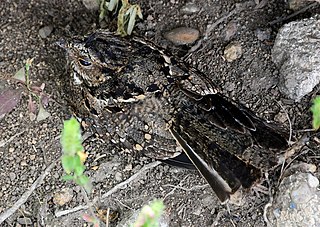
Anthony's nightjar, also known as the scrub nightjar, is a species of nightjar in the family Caprimulgidae. It is found in Ecuador and Peru.

The Yucatan nightjar is a species of nightjar in the family Caprimulgidae. It is found in Belize, Guatemala, Mexico, and Honduras.
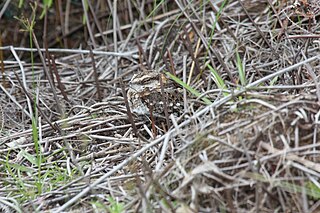
The white-tailed nightjar is a species of nightjar in the family Caprimulgidae. It is found in the tropic regions of Central and South America.

The Cuban nightjar, sometimes also Greater Antillean nightjar, is a species of nightjar in the family Caprimulgidae. It is endemic to Cuba.

The pygmy nightjar is a species of nightjar in the family Caprimulgidae. It is endemic to Brazil.

The spot-tailed nightjar is a species of nightjar in the family Caprimulgidae. It is found in Honduras, Mexico, Nicaragua, and every mainland South American country except Chile and Uruguay.

The blackish nightjar is a species of bird in the family Caprimulgidae. It is found in Brazil, Bolivia, Colombia, Ecuador, French Guiana, Guyana, Peru, Suriname, and Venezuela.
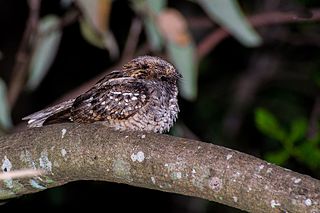
The little nightjar is a species of nightjar in the family Caprimulgidae. It is found in Argentina, Bolivia, Brazil, Paraguay, Peru, and Uruguay.

The fiery-necked nightjar is a species of nightjar in the family Caprimulgidae, which is found mostly in Africa south of the equator, though it has been spotted in a few countries north of the equator. It is most often found in woodland savannas or other deciduous woodlands. It is usually distinguished by its tawny coloured collar which gives the species its common name. It has a distinctive call that many have rendered as 'good-lord-deliver-us'. The fiery-necked nightjar is an insectivorous species that mostly eats butterflies, moths and other insects. The fiery-necked nightjar breeds after the dry season and typically produce two clutches with two eggs per clutch.

The Roraiman nightjar is a species of nightjar in the family Caprimulgidae. It is found in Brazil, Guyana, and Venezuela.

The sickle-winged nightjar is a species of nightjar in the family Caprimulgidae. It is found in Argentina, Brazil, Paraguay and possibly Uruguay.

The spotted nightjar or spotted eared-nightjar is a species of nightjar in the family Caprimulgidae. It inhabits much of mainland Australia and has also been found in several Indonesian islands. Its natural habitats are open forests and woodlands, scrub, spinifex and tussock grassland, savannah woodland and mangroves.

The scissor-tailed nightjar is a species of nightjar in the family Caprimulgidae. It is distributed over much of eastern South America.

The short-tailed nighthawk is a species of nightjar in the family Caprimulgidae. It is found in Mexico, in every Central American country except El Salvador, in Trinidad and Tobago, and in every mainland South American country except Chile and Uruguay.

The long-trained nightjar is a species of nightjar in the family Caprimulgidae. It is found in Argentina and Brazil.

The ocellated poorwill is a species of nightjar in the family Caprimulgidae. It is found in Argentina, Bolivia, Brazil, Colombia, Costa Rica, Ecuador, Honduras, Nicaragua, Paraguay, and Peru.

The Chocó poorwill is a species of nightjar in the family Caprimulgidae. It is found in Colombia and Ecuador.
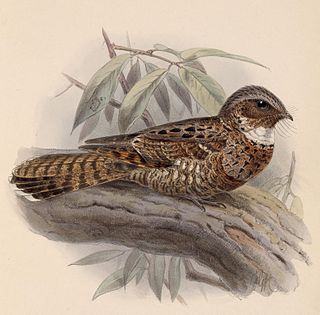
The Yucatan poorwill is a species of nightjar in the family Caprimulgidae. It is found in the Yucatán Peninsula of Belize, Guatemala, and Mexico.
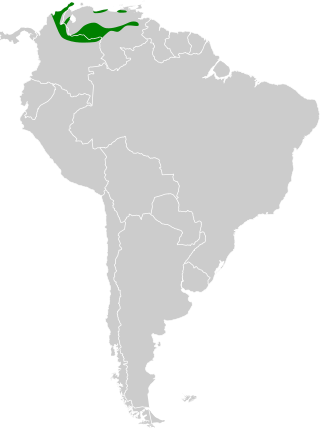
Todd's nightjar is a species of nightjar in the family Caprimulgidae. It is found in Brazil, Colombia, Guyana, and Venezuela.

Tschudi's nightjar or lesser band-winged nightjar is a species of nightjar in the family Caprimulgidae. It is found in Chile and Peru.























